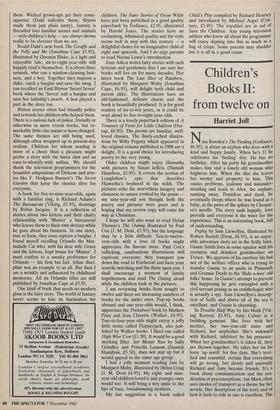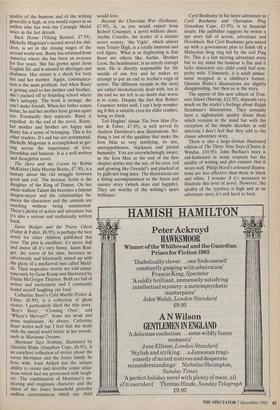Children's Books II: from twelve on
Harriet Joll
ina Bawden's The Finding (Gollancz, £6.95), is about an orphan who lives with a kind and happy family. When he's 11 he celebrates his 'finding' day. He has no birthday. After his party his grandmother makes him visit a lonely old woman who frightens him. When she dies she leaves her money and property to him. This causes problems, jealousy and misunder- standing and leads to Alex, the orphan, running away. Penniless and tired, he eventually sleeps where he was found as a baby, in the paws of the sphinx by Cleopat- ra's needle. The story ends happily, love prevails and everyone is the wiser for the experience. This is an interesting book, full of understanding.
Pegleg by Sam Llewellyn, illustrated by Robert Bartelt (Dent, £6.95), is an enjoy- able adventure story set in the Scilly Isles. Gussie Smith lives in some squalor with his eccentric and drunken grandmother on Tresco. We approve of his carefree life but not of the welfare officer who is trying to transfer Gussie to an uncle in Plymouth and Grannie Doyle to the 'Bide-a-wee' old folks' home. In Gussie's attempt to prevent this happening he gets entangled with a civil servant posing as an ornithologist who is actually a spy. Sam Llewellyn's descrip- tion of Scilly and above all of the sea is excellent, and Gussie is charming.
In Trouble Half-Way by Jan Mark (Vik- ing Kestrel, £5.95), Amy Calver is a budding gymnast. She lives with her mother, her two-year-old sister and Richard, her stepfather. She's awkward with Richard, inhibited by his presence. When her grandmother's is taken ill, they are thrown together. He takes her on his lorry 'up north' for five days. She's terri- fied and resentful, certain that everything will go wrong, but slowly and unevenly Richard and Amy become friends. It's a book about communication and the era- dication of preconceptions. Jan Mark often uses modes of transport as a theme for her novels. Her description of the lorry and of how it feels to ride in one is excellent. The quality of the humour and of the writing generally is high, as you would expect in an author who has won the Carnegie Medal twice in the last decade.
Back Home (Viking Kestrel, £7.95), Michelle Magorian's second novel for chil- dren, is set in the closing stages of the second world war. Rusty has returned from America where she has been an evacuee for five years. She has grown apart from English life and is unused to shortages and drabness. Her return is a shock for both her and her mother. Again, communica- tion is the main problem. Just when Rusty is getting used to her mother and brother, she's packed off to boarding school where she's unhappy. The work is strange, she can't make friends. When her father comes home, he and her mother have grown apart too. Eventually they separate. Rusty is expelled. At the end of the novel, Rusty, her mother and brother are happy and Rusty has a sense of belonging. This is for older readers. It's sad but not sentimental. Michelle Magorian is accomplished at get- ting across the importance of love, friendship and humour. It is a well written and thoughtful novel.
The Hero and the Crown by Robin McKinley (Julia Macrae Books, £7.50), is a fantasy about the old struggle between good and evil. The heroine Aerin is the daughter of the King of Damar. On her white stallion Talant she becomes a famous dragon-slayer and the relationships be- tween the characters and the animals are touching without being sentimental. There's plenty of action and adventure but it's also a serious and realistically written book.
Jason Bodger and the Priory Ghost (Faber & Faber, £6.95), is perhaps the best novel for older children published this year. The plot is excellent, it's never dull and above all it's very funny. Jason Bod- ger, the terror of his class, becomes in- advertently and hilariously mixed up with the ghost of a mediaeval nun called Matil- da. Their respective stories are told simul- taneously by Gene Kemp and illustrated by Elaine McGregor Thurney. Both are full of action and excitement and I constantly found myself laughing out loud.
Catherine Storr's Cold Marble (Faber & Faber, £6.95), is a collection of ghost stories. I particularly liked the title story, `Boy's Story', 'Crossing Over', and `Where's Mervyn?'. Some are weak and some unpleasant. As always, Catherine Storr writes well but I feel that she deals with the unreal world better in her novels, such as Marianne Dreams.
Mortimer Says Nothing, illustrated by Quentin Blake (Jonathan Cape, £6.95), is an excellent collection of stories about the raven Mortimer and the Jones family he lives with. Joan Aitken has the unique ability to create and describe comic situa- tions which had me prostrated with laugh- ter. The combination of Mortimer's en- dearing and enigmatic character and the chaos of the Jones household provides endless entertainment which any child would love.
Beyond the Chocolate War (Gollancz, £7.95), is, as you would expect from Robert Courmier, a novel without cheer. Archie Costello, the leader of a sinister secret society, 'the Vigils', which almost runs Trinity High, is a totally immoral and evil figure. What is so frightening is that there are others like Archie. Brother Leon, the headmaster, is an utterly corrupt man. He is directly responsible for the suicide of one boy and he makes no attempt to put an end to Archie's reign of terror. The different strands in the story are rather inconclusively dealt with, but at the end we are left in no doubt that worse is to come. Despite the fact that Robert Courmier writes well, I can't help wonder- ing if this is suitable even for older readers, being so black.
Ted Hughes' classic The Iron Man (Fa- ber & Faber, £7.95), is well served by Andrew Davidson's new illustrations. No- thing is lost of the qualities that make the Iron Man so very terrifying, its size, unstoppableness, blackness and partial humanity. You are overwhelmingly aware, as the Iron Man at the end of the first chapter settles into the sea, of his eyes, red and glowing like Grendel's and plucked at by gulls not long since. The illustrations are a fitting accompaniment to the fierce and sinister story (which does end happily). They are worthy of the writing's spare brilliance. Cyril Bonhamy in his latest adventure in Cyril Bonhamy and Operation Ping (Jonathan Cape, £5.95), is in financial straits. His publisher suggests he writes a spy story full of action, adventure and bloodshed. But Cyril Bonhamy gets mixed up with a government plan to finish off a Malaysian drug ring led by the evil Ping Po. This is a fast moving adventure story but to my mind the humour is flat and it lacks characters any child could feel sym- pathy with. Ultimately, it is adult amuse- ment wrapped in a children's format. Quentin Blake's illustrations are slightly disappointing, but then so is the story.
The appeal of this new edition of Trea- sure Island (Harrap, £12.95), depends very much on the reader's feelings about Ralph Steadman's illustrations. They certainly have a nightmarish quality about them which remains in the mind but with the exception of the simple sketches at odd intervals I don't feel that they add to the classic adventure story.
There is also a large-format illustrated edition of The Thirty Nine Steps (Chatto & Windus, £10.95). John Buchan's story is old-fashioned in many respects but the quality of writing and plot ensures that it wears well. Philip Hood's coloured illustra- tions are less effective than those in black and white. I wonder if it's necessary to illustrate this level of novel. However, the quality of the typeface is high and as an adventure story it's still hard to beat.



































































 Previous page
Previous page